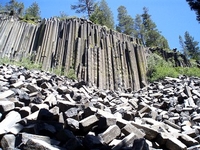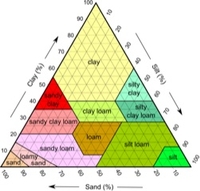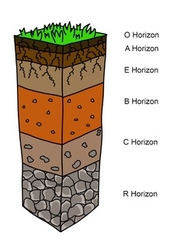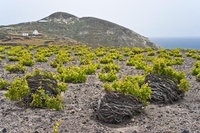|
|
 |

Reference to soil is a constant when it comes to detailed discussions about vineyards. Wine marketers frequently refer to the limestone, granite, alluvial, glacial, or whatever soil type exists in the vineyard as giving the grapes distinctive and favorable characteristics.
Alluvial Soil in Lodi, California
While there is no science that shows a human can taste limestone, granite, or any other rock type in wine, as students of wine we know that vines drawn from different soils smell and taste differently. We must logically conclude that it is not the taste of the rock, but something else that gives a resultant wine its distinction. Anyone who works in a vineyard knows that soils do make a difference in wine quality, but it likely has more to do with organic composition, pH, drainage and cation exchange capacity than rock type.
There is confusion about geologic terms among those not imbued with the jargon of the geologic science community. Elements, rocks and minerals are distinctive and separate categories. Elements are substances which cannot be reduced to a simpler form. Some vineyards are noted for their soil composition that includes Manganese, Iron or Copper, which are elements. In fact, most elements combine with other ions to form minerals with more obscure names than the elements. Minerals are naturally occurring solids with a specific chemical composition and structure. Compounds like gypsum, flint and bauxite are minerals and sometimes appear in vineyard soil descriptions. Rocks do not have a specific chemical composition or structure and can vary in appearance and physical properties based on their components. Limestone, slate, granite and schist are rocks.
Soil is too often simplified and considered synonymous with its underlying geology. While soil is derived from rocks, there are many steps in the process of converting a relatively sterile base material into a fertile soil. Most rocks are formed under high heat and pressure conditions far below the earth’s surface. When they are uplifted to the earth’s surface by geologic movements, they are no longer stable and are subject to breakdown.
The process of breaking down rocks is called weathering. Weathering can be mechanical or chemical. Mechanical weathering breaks rocks into smaller pieces by gravity, physical force or by repeated freezing and thawing of water. Chemical weathering changes the mineral composition of the rock by interaction with natural acids, water and oxygen. Once weathered, rock fragments can be transported by gravity, wind and water. This can be the start of the soil development process.

Mechanical Weathering by Gravity at
Devil’s Postpile National Monument, California
Although soil is only a thin veneer on the earth’s land surface, it is a crucial interface that is essential to life on earth. Soil is a combination of organic and inorganic material that can support plant growth and is thus the foundation of terrestrial ecosystems. There is no consistency in soil properties from site to site and soils vary considerably in depth, fertility, chemical and organic content. We can say generally that soils are a combination of rock fragments, minerals, gases, water, microbes and higher life forms. Soil science is the study of these components and how they interact to support plant life.

USDA Soil Texture Classification
Soil components vary from place to place, of course, but an “average” soil might be composed of 25% air, 25% water, 45% rocks and minerals, and 5% organic matter. The rock and mineral portion is often described based on particle size. Soils are composed of sand, silt and clay with sand being the largest and clay the smallest particles. Soils with all three components are often described as loam soils. There can be sandy loams, clay loams, silty clay loams and so on. Soil drainage properties are closely related to their particle size components.
There are several factors that allow soils to support plant life. Soil aeration allows the presence of oxygen to enhance root growth. Soil heats and cools more slowly that air and provides a moderating influence for temperature, protecting plants from extremes of air temperatures. Soil retains water that is essential for plant survival. It is also a reservoir of minerals needed for plant growth as well as a harbor for organic material that enhances aeration and plant health.

Soil Profile Diagram
As soils develop, they form layers that are described as soil horizons. The top layer is the Organic layer with fresh and decaying plant and animal material. Beneath that is the topsoil or A horizon with some organic components but dominated by minerals and rock particles. Most root growth occurs in the topsoil. Beneath the topsoil are the subsoil, substratum and finally bedrock – the parent material of the soil. Soils are commonly referred to by the parent material, but it is clear that the topsoil can be quite different than the parent. Temperature, moisture, sunshine, animal presence and passage of time will all affect the character of the soil.
Soils vary widely and not all develop the horizon sequence described above. In the wine trade we find references to limestone, granite, slate and schist soils – terms which refer to the parent material of the soil. We also find references to alluvial and colluvial soils. Alluvial soils are transported soils, removed from the parent rock by water. They often have varied interbedded components of sand, silt, gravel, clay and even cobbles and boulders. Colluvial soils are transported soils as well but are moved primarily by gravity. They form at the base of steep slopes where gravity action is most powerful. Colluvial soils tend to have larger rock fragments mixed with smaller particles.

Volcanic Soil & Vineyard on Santorini
Volcanic soils are derived from volcanic rocks which are erupted onto the earth’s surface rather than created by heat and pressure deep below the surface. Volcanic soils can have a wide variety of characteristics based on the chemical composition of the parent rocks. Many areas have aeolian soils, those deposited by wind. Loess is the most common aeolian soil among vineyards. Glacial soils are transported soils which are moved by the action of glacial ice and meltwater.
Within each type of soil, there are many differences based on local conditions. The variety of soils is as broad as the variety of wines that are drawn from the vineyards that grow from them. Soil science is an area of study critical to understanding agriculture of all types. Winegrowing is just one small aspect of the soil science world. Greater understanding of soil and all its variations can help a wine lover understand why specific sites yield such special wines.
|
 |
|